Abstract
BACKGROUND: Neck circumference has been suggested to be more predictive of obstructive sleep apnoea than general obesity, but the statistical validity of this conclusion has been questioned. Combining neck circumference with other signs and symptoms may allow the clinical diagnosis or exclusion of sleep apnoea to be made with reasonable confidence. This study examines these issues. METHODS: One hundred and fifty patients referred to a sleep clinic for investigation of sleep related breathing disorders completed a questionnaire covering daytime sleepiness, snoring, driving, and nasal disease. Body mass index and neck circumference corrected for height were measured and obstructive sleep apnoea severity was quantified as number of dips in arterial oxygen saturation (SaO2) of more than 4% per hour of polysomnography. Multiple linear regression was used retrospectively to identify independent predictors of SaO2 dip rate, and the model derived was then prospectively tested in a further 85 subjects. RESULTS: The retrospective analysis showed that the question "Do you fall asleep during the day, particularly when not busy?" was the best questionnaire predictor of variance in the SaO2 dip rate (r2 = 0.13); no other question improved this correlation. This analysis also showed that neither body mass index nor any of the questionnaire variables improved the amount of variance explained by height corrected neck circumference alone (r2 = 0.35). A statistically similar prospective analysis confirmed this relationship (r2 = 0.38). CONCLUSIONS: Prospective study of these patients referred to a sleep clinic with symptoms suggesting sleep apnoea shows that neck circumference corrected for height is more useful as a predictor of obstructive sleep apnoea than general obesity. None of the questionnaire variables examined add to its predictive power, but alone it is inadequate to avoid the need for sleep studies to diagnose this disease.
Full text
PDF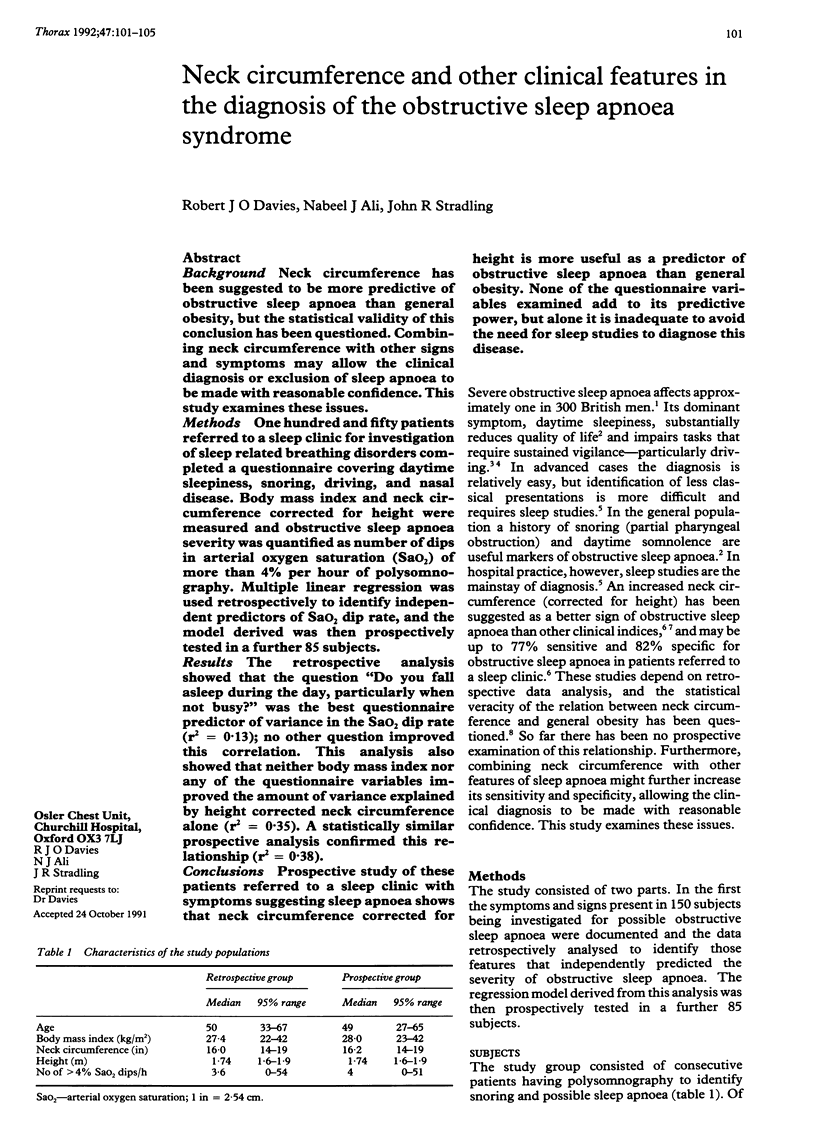
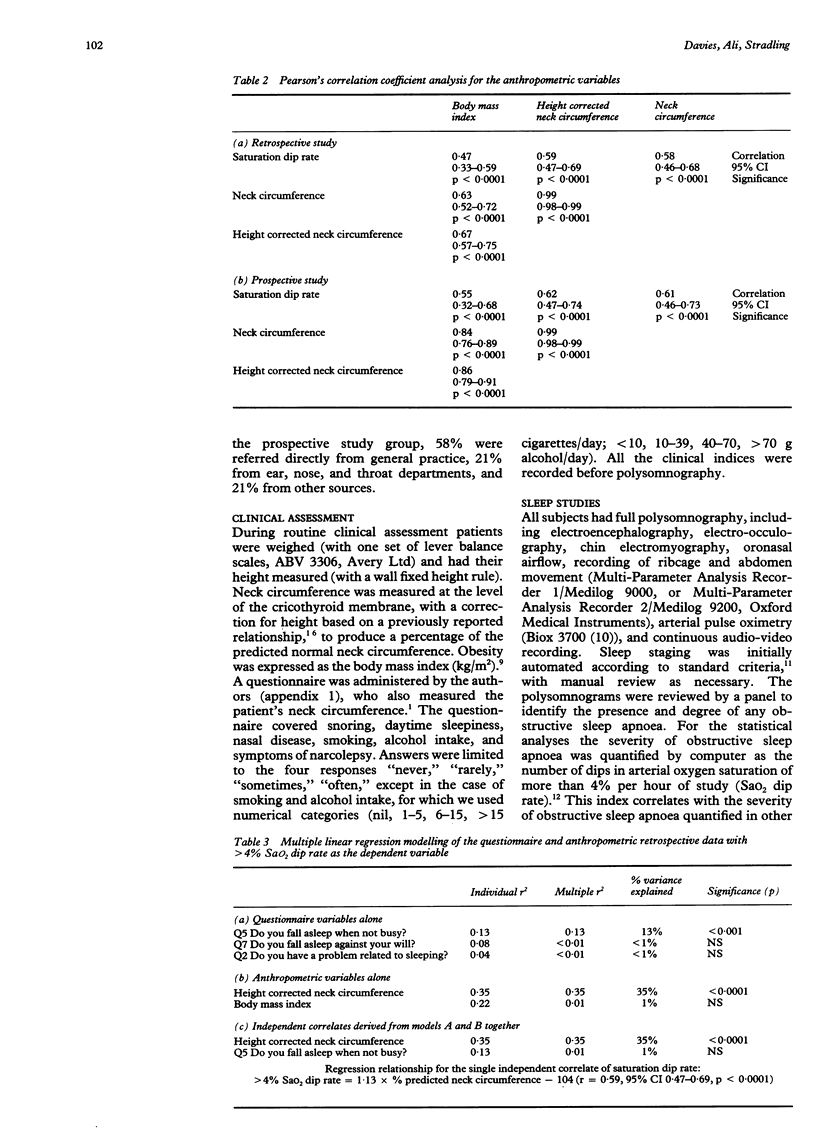
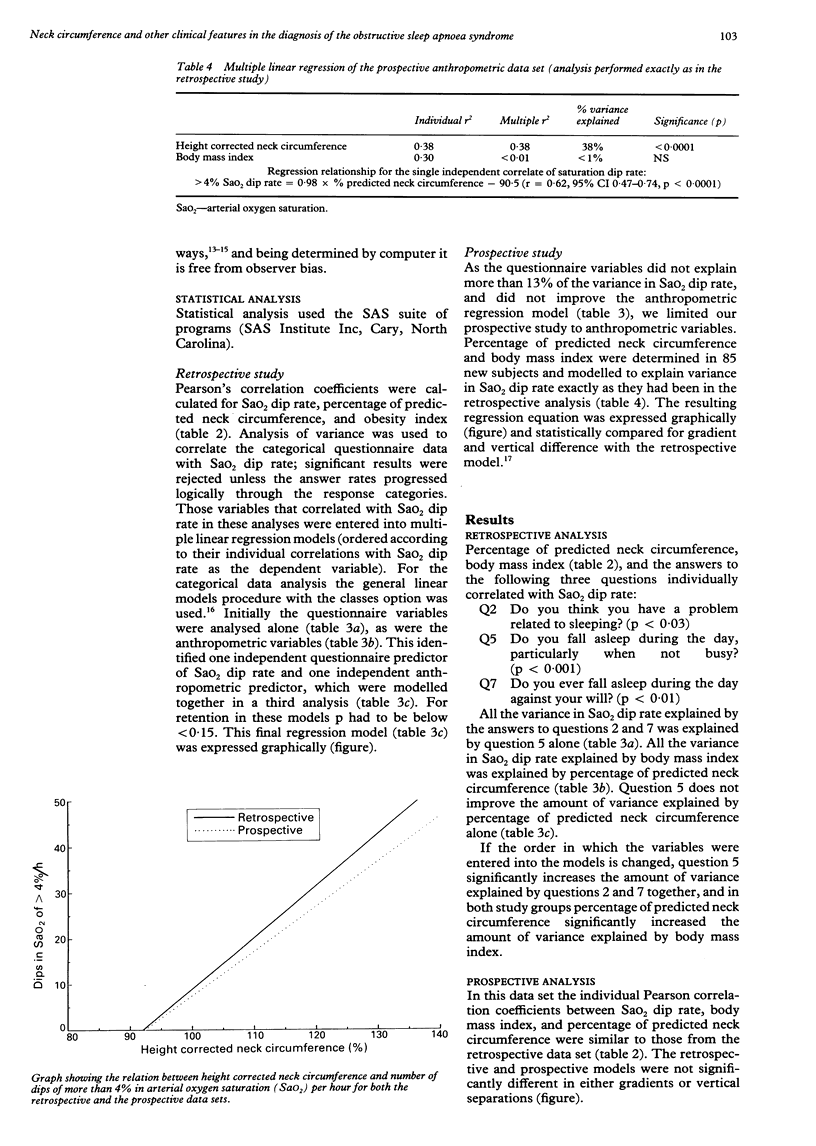
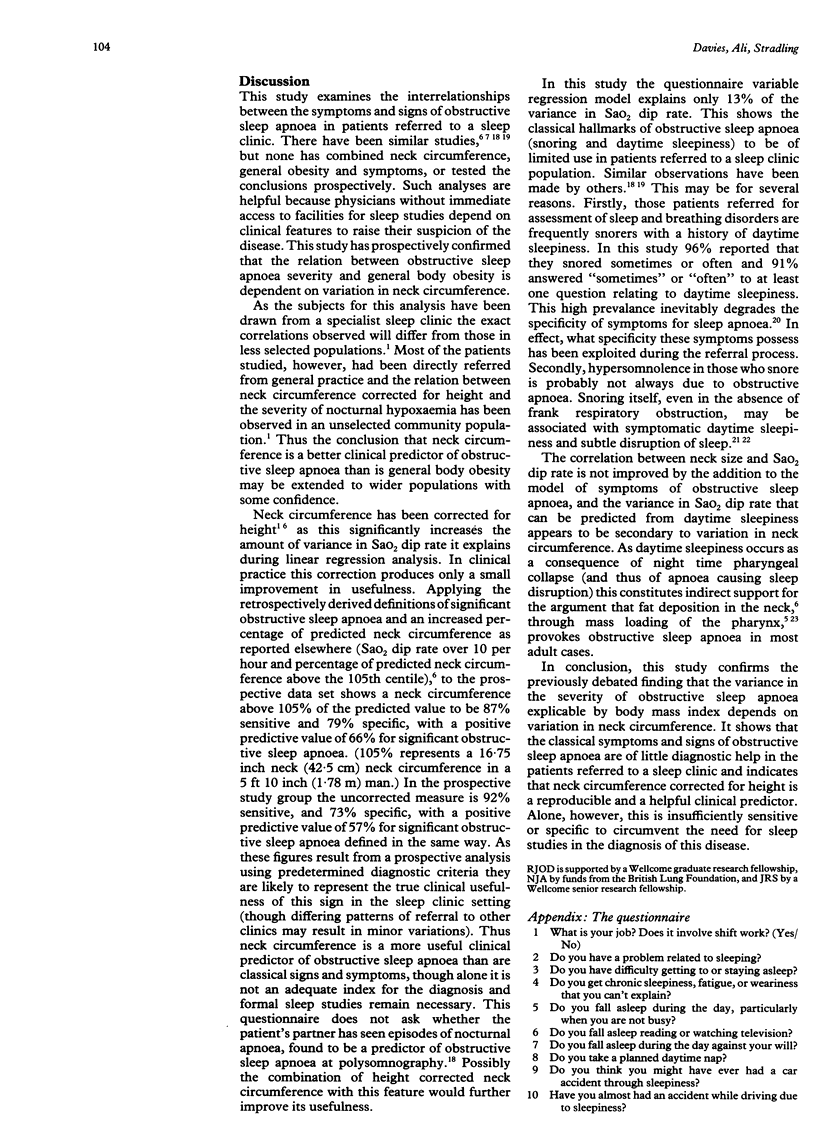
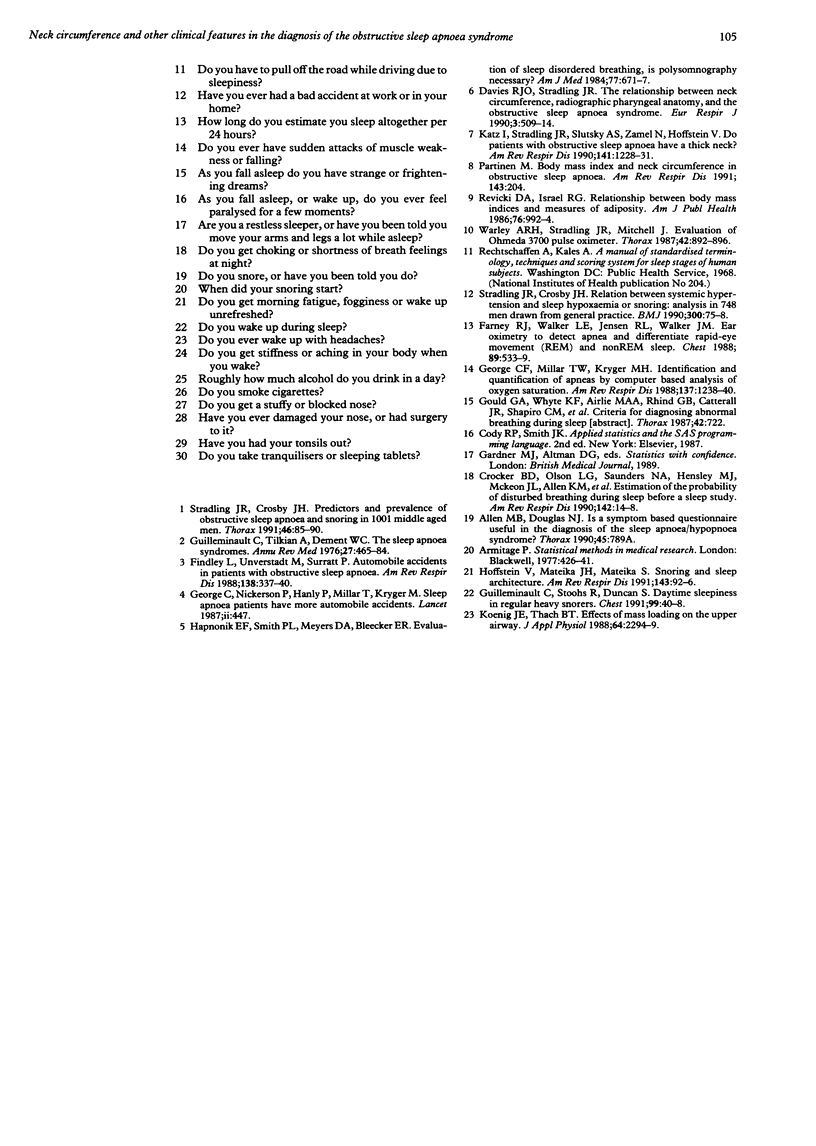
Selected References
These references are in PubMed. This may not be the complete list of references from this article.
- Crocker B. D., Olson L. G., Saunders N. A., Hensley M. J., McKeon J. L., Allen K. M., Gyulay S. G. Estimation of the probability of disturbed breathing during sleep before a sleep study. Am Rev Respir Dis. 1990 Jul;142(1):14–18. doi: 10.1164/ajrccm/142.1.14. [DOI] [PubMed] [Google Scholar]
- Davies R. J., Stradling J. R. The relationship between neck circumference, radiographic pharyngeal anatomy, and the obstructive sleep apnoea syndrome. Eur Respir J. 1990 May;3(5):509–514. [PubMed] [Google Scholar]
- Farney R. J., Walker L. E., Jensen R. L., Walker J. M. Ear oximetry to detect apnea and differentiate rapid eye movement (REM) and non-REM (NREM) sleep. Screening for the sleep apnea syndrome. Chest. 1986 Apr;89(4):533–539. doi: 10.1378/chest.89.4.533. [DOI] [PubMed] [Google Scholar]
- Findley L. J., Unverzagt M. E., Suratt P. M. Automobile accidents involving patients with obstructive sleep apnea. Am Rev Respir Dis. 1988 Aug;138(2):337–340. doi: 10.1164/ajrccm/138.2.337. [DOI] [PubMed] [Google Scholar]
- George C. F., Millar T. W., Kryger M. H. Identification and quantification of apneas by computer-based analysis of oxygen saturation. Am Rev Respir Dis. 1988 May;137(5):1238–1240. doi: 10.1164/ajrccm/137.5.1238. [DOI] [PubMed] [Google Scholar]
- George C. F., Nickerson P. W., Hanly P. J., Millar T. W., Kryger M. H. Sleep apnoea patients have more automobile accidents. Lancet. 1987 Aug 22;2(8556):447–447. doi: 10.1016/s0140-6736(87)90974-3. [DOI] [PubMed] [Google Scholar]
- Guilleminault C., Stoohs R., Duncan S. Snoring (I). Daytime sleepiness in regular heavy snorers. Chest. 1991 Jan;99(1):40–48. doi: 10.1378/chest.99.1.40. [DOI] [PubMed] [Google Scholar]
- Guilleminault C., Tilkian A., Dement W. C. The sleep apnea syndromes. Annu Rev Med. 1976;27:465–484. doi: 10.1146/annurev.me.27.020176.002341. [DOI] [PubMed] [Google Scholar]
- Haponik E. F., Smith P. L., Meyers D. A., Bleecker E. R. Evaluation of sleep-disordered breathing. Is polysomnography necessary? Am J Med. 1984 Oct;77(4):671–677. doi: 10.1016/0002-9343(84)90361-9. [DOI] [PubMed] [Google Scholar]
- Hoffstein V., Mateika J. H., Mateika S. Snoring and sleep architecture. Am Rev Respir Dis. 1991 Jan;143(1):92–96. doi: 10.1164/ajrccm/143.1.92. [DOI] [PubMed] [Google Scholar]
- Katz I., Stradling J., Slutsky A. S., Zamel N., Hoffstein V. Do patients with obstructive sleep apnea have thick necks? Am Rev Respir Dis. 1990 May;141(5 Pt 1):1228–1231. doi: 10.1164/ajrccm/141.5_Pt_1.1228. [DOI] [PubMed] [Google Scholar]
- Koenig J. S., Thach B. T. Effects of mass loading on the upper airway. J Appl Physiol (1985) 1988 Jun;64(6):2294–2299. doi: 10.1152/jappl.1988.64.6.2294. [DOI] [PubMed] [Google Scholar]
- Partinen M. Body mass index and neck circumference in obstructive sleep apnea. Am Rev Respir Dis. 1991 Jan;143(1):204–204. doi: 10.1164/ajrccm/143.1.204. [DOI] [PubMed] [Google Scholar]
- Revicki D. A., Israel R. G. Relationship between body mass indices and measures of body adiposity. Am J Public Health. 1986 Aug;76(8):992–994. doi: 10.2105/ajph.76.8.992. [DOI] [PMC free article] [PubMed] [Google Scholar]
- Stradling J. R., Crosby J. H. Predictors and prevalence of obstructive sleep apnoea and snoring in 1001 middle aged men. Thorax. 1991 Feb;46(2):85–90. doi: 10.1136/thx.46.2.85. [DOI] [PMC free article] [PubMed] [Google Scholar]
- Stradling J. R., Crosby J. H. Relation between systemic hypertension and sleep hypoxaemia or snoring: analysis in 748 men drawn from general practice. BMJ. 1990 Jan 13;300(6717):75–78. doi: 10.1136/bmj.300.6717.75. [DOI] [PMC free article] [PubMed] [Google Scholar]
- Warley A. R., Mitchell J. H., Stradling J. R. Evaluation of the Ohmeda 3700 pulse oximeter. Thorax. 1987 Nov;42(11):892–896. doi: 10.1136/thx.42.11.892. [DOI] [PMC free article] [PubMed] [Google Scholar]


